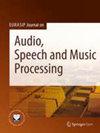Improving speech recognition systems for the morphologically complex Malayalam language using subword tokens for language modeling
IF 1.9
3区 计算机科学
引用次数: 0
Abstract
Abstract This article presents the research work on improving speech recognition systems for the morphologically complex Malayalam language using subword tokens for language modeling. The speech recognition system is built using a deep neural network–hidden Markov model (DNN-HMM)-based automatic speech recognition (ASR). We propose a novel method, syllable-byte pair encoding (S-BPE), that combines linguistically informed syllable tokenization with the data-driven tokenization method of byte pair encoding (BPE). The proposed method ensures words are always segmented at valid pronunciation boundaries. On a text corpus that has been divided into tokens using the proposed method, we construct statistical n-gram language models and assess the modeling effectiveness in terms of both information-theoretic and corpus linguistic metrics. A comparative study of the proposed method with other data-driven (BPE, Morfessor, and Unigram), linguistic (Syllable), and baseline (Word) tokenization algorithms is also presented. Pronunciation lexicons of subword tokenized units are built with pronunciation described as graphemes. We develop ASR systems employing the subword tokenized language models and pronunciation lexicons. The resulting ASR models are comprehensively evaluated to answer the research questions regarding the impact of subword tokenization algorithms on language modeling complexity and on ASR performance. Our study highlights the strong performance of the hybrid S-BPE tokens, achieving a notable 10.6% word error rate (WER), which represents a substantial 16.8% improvement over the baseline word-level ASR system. The ablation study has revealed that the performance of S-BPE segmentation, which initially underperformed compared to syllable tokens with lower amounts of textual data for language modeling, exhibited steady improvement with the increase in LM training data. The extensive ablation study indicates that there is a limited advantage in raising the n-gram order of the language model beyond $$n=3$$使用子词标记进行语言建模,以改善形态复杂马拉雅拉姆语的语音识别系统
摘要本文介绍了利用子词标记进行语言建模来改进马拉雅拉姆语语音识别系统的研究工作。采用基于深度神经网络隐马尔可夫模型(DNN-HMM)的自动语音识别(ASR)技术构建语音识别系统。我们提出了一种新的方法,音节-字节对编码(S-BPE),它结合了语言信息的音节标记化和数据驱动的字节对编码(BPE)标记化方法。所提出的方法确保单词总是在有效的发音边界上被分割。在使用所提出的方法将文本语料库划分为标记的基础上,我们构建了统计n-gram语言模型,并从信息论和语料库语言度量两方面评估了建模的有效性。本文还将该方法与其他数据驱动(BPE、morfessand Unigram)、语言(Syllable)和基线(Word)标记化算法进行了比较研究。子词分词单元的发音词典是用描述为字素的发音来构建的。我们开发了使用子词标记化语言模型和发音词汇的ASR系统。对所得的ASR模型进行了综合评价,以回答有关子词标记化算法对语言建模复杂性和ASR性能的影响的研究问题。我们的研究强调了混合S-BPE令牌的强劲表现,达到了显著的10.6% word error rate (WER), which represents a substantial 16.8% improvement over the baseline word-level ASR system. The ablation study has revealed that the performance of S-BPE segmentation, which initially underperformed compared to syllable tokens with lower amounts of textual data for language modeling, exhibited steady improvement with the increase in LM training data. The extensive ablation study indicates that there is a limited advantage in raising the n-gram order of the language model beyond $$n=3$$ n = 3 . Such an increase results in considerable model size growth without significant improvements in WER. The implementation of the algorithm and all associated experiments are available under an open license, allowing for reproduction, adaptation, and reuse.
本文章由计算机程序翻译,如有差异,请以英文原文为准。
求助全文
约1分钟内获得全文
求助全文
来源期刊

Journal on Audio Speech and Music Processing
Engineering-Electrical and Electronic Engineering
CiteScore
4.10
自引率
4.20%
发文量
28
期刊介绍:
The aim of “EURASIP Journal on Audio, Speech, and Music Processing” is to bring together researchers, scientists and engineers working on the theory and applications of the processing of various audio signals, with a specific focus on speech and music. EURASIP Journal on Audio, Speech, and Music Processing will be an interdisciplinary journal for the dissemination of all basic and applied aspects of speech communication and audio processes.
 求助内容:
求助内容: 应助结果提醒方式:
应助结果提醒方式:


